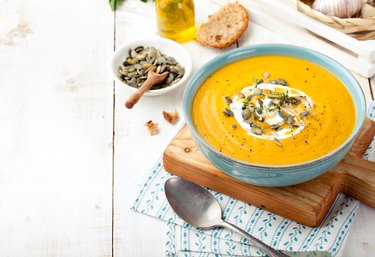
Butternut squash soup is a healthy yet comforting dish that is especially popular in colder seasons. Serving nutritious sides with this soup can make it into a balanced meal. Simply prepare more vegetables and protein to eat with butternut squash soup to increase your nutrient intake.
This vegetable soup is also a great way to meet your recommended servings of vegetables. Butternut squash soup is a great option for anyone looking to get more fiber, vitamins and minerals.
Video of the Day
Video of the Day
There are many butternut squash soup recipes to follow for a healthy homemade version. You can also buy premade soup at most grocery stores. If canned or frozen, look for a low-sodium option to avoid too much salt.
Benefits of Butternut Squash Soup
Since butternut squash is the main ingredient, many of the benefits of butternut squash soup can be attributed to this vegetable. According to Harvard Health Publishing, butternut squash is a type of winter squash. They are rich in carotenoids, which may protect against cancer.
According to the USDA, 1 cup of cooked butternut squash contains the following:
- 82 calories
- 0.2 grams of fat
- 21.5 grams of carbohydrates
- 6.6 grams of fiber
- 1.9 grams of protein
- 127 percent daily value (DV) of vitamin A
- 34 percent DV of vitamin C
- 18 percent DV of vitamin E
- 14 percent DV of magnesium
- 12 percent DV of potassium
Though butternut squash is not a no-carb vegetable, it is a potent source of many nutrients. One serving contains more than a quarter of your daily fiber requirements.
According to a study published in the January-February 2017 issue of the American Journal of Lifestyle Medicine, only 5 percent of the U.S. population consumes the recommended amount of fiber. With 6.6 grams per serving, consuming butternut squash soup is one easy way to increase your fiber intake.
Read more: How to Boil Butternut Squash
Sides for Butternut Squash Soup
If butternut squash soup is your main entree, you may want to brainstorm some side dish ideas. Sides for butternut squash soup can include a protein source, salad, whole-grain crackers or cooked vegetables.
Soup and salad are a classic duo. This is why it is no surprise that many sides for butternut squash soup consist of salads. Fortunately, salad recipes are practically endless. Since butternut squash is a fall and winter vegetable, you can stick to this theme. Go for salads that contain Brussels sprouts, cranberries, root vegetables and apples.
Other sides for butternut squash soup may include a seasoned roasted vegetable dish. If you are making butternut squash soup in the fall or winter, then root vegetables will be in season. Start by chopping turnips, carrots, sweet potatoes, parsnips and beets. Place them on a baking sheet with olive oil, herbs and spices. Roast in the oven until they are tender, and you will have a delicious side for butternut squash soup.
A protein source can also complement a butternut squash soup. For vegetarians and vegans, baked tofu is a protein to eat with butternut squash soup. A bean dish also pairs nicely with this plant-based soup.
Read more: What Does Butternut Squash Go With?
Butternut Squash Soup Toppings
Since butternut squash tends to be pureed into a thick and creamy liquid soup, you may want to add texture with some toppings. Butternut squash soup toppings vary depending on your preferences.
Some popular butternut squash soup toppings include fresh herbs, pumpkin seeds, pomegranate seeds, diced apples, diced pears and kale chips. You can also make your own butternut squash soup toppings by crumbling crackers, croutons or crispy tortillas. This will add some crunch to the soup.
If you are looking for a protein to eat with butternut squash soup, adding nuts and seeds will suffice. They will also serve as a nice soup topping with added nutrients.